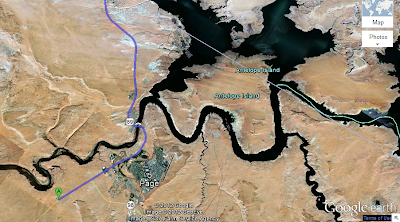US ROUTE 89 from Page arrives at Kanab, a small town where we lodged for the last day of the canyon tour. In the morning we will ride through the Zion National Park ( green area, center of the map) and then take Interstate 15( transverse yellow road on the left of the map ) to Hoover Dam out side Las Vegas. From Vegas we'll fly back to New York by the 10 PM Delta Flight.
Typical sight on the road from Kanab to Zion Park
A Pizza joint just outside the Park.
Welcome Sign. You can see the the beginning of the typical limestone rocks.
Entrance to the Park where you take the tickets for the car.
Lime stone rock formations. You can ride the entire length of the park in your car
and go out through the other entrance. Gaze up at
massive sandstone cliffs of cream, pink, and red that soar into a
brilliant blue sky.
Even the roads is surfaced to match the colour of the enviorment.
Travelers get out to make side tours through the Park to see water falls and valleys.
The Grand Canyon is abut 150 miles to its south.
Zion Canyon Scenic Drive and Echo Canyon are not far of the East Rim Trail.
You have to spend at least 3 days here to do justice to the place.
You have to spend at least 3 days here to do justice to the place.
Zion National Park features stunning scenery, sandstone cliffs which are among the
highest in the world, with diverse plant and animal communities.
Once home to ancient Indian tribes Puebloan & Paiute and later
white Mormon pioneer settlers.
The Road passes through a couple of tunnels.
Samall tunnel, can see the other end
View from the inside of the longer tunnel
This tunnel has a side windows to the valley side
A few miles down the road, this opening can be seen from the valley below.
Outside
Winding road.
This is the paths where ancient native people and pioneers of Americam settement walked.
Taking a picture of the tunnel window
Exit of the Park at the other end.
The park is kept in a pristine condition. Zion’s unique range of plants and animals will enchant you as you absorb
the rich history of the past and enjoy the place that has hardly changed to the present day, except, perhaps for the good road.
On way to get into Interstate 15 to Nevada.



























































